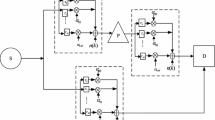Abstract
Cooperative diversity techniques have been utilized to improve the energy efficiency of wireless sensor networks (WSNs) operating over flat fading channels in a considerable number of literature. However, wireless channels of WSNs operating in indoor environments are supposed to be characterised by frequency-selective fading. Theoretical analysis of energy efficient cooperative communications in WSNs operating in indoor environments are rarely addressed. Therefore, this paper studies the energy efficient cooperative communications in WSNs operating over frequency-selective fading channels. Closed-form bit error rate expressions are derived for systems over frequency-selective fading channels. In order to fully explore the energy conservation potential of cooperative communications, solutions of the optimal transmit power allocation and the partner node selection are provided. Moreover, it is proven that the communication quality can be greatly improved by using chip-interleaving techniques in WSNs subject to flat fading channels. Thus, this paper investigates the energy-saving potential of chip-interleaved transceivers in WSNs subject to frequency-selective fading. Numerical results show that significant energy savings can be achieved via cooperations with chip-interleaved transceivers in WSNs operating in indoor environments.












Similar content being viewed by others
References
Shah, A. F. M. S., & Islam, M. S. (2014). A survey on cooperative communication in wireless networks. International Journal of Intelligent Systems and Applications (IJISA), 6(7), 66.
Feng, D., Jiang, C., Lim, G., et al. (2013). A survey of energy efficient wireless communications. IEEE Communications Surveys and Tutorials, 15(1), 167–178.
Liang, X., Chen, M., Balasingham, I., & Leung, V. C. M. (2013). Cooperative communications with relay selection for wireless networks: Design issues and applications. Wireless Communications and Mobile Computing, 13(8), 745–759.
Rault, T., Bouabdallah, A., & Challal, Y. (2014). Energy efficiency in wireless sensor networks: A top-down survey. Computer Networks, 67(4), 104–122.
Cai, X. B., & Cao, H. K., et al. (2010). Virtual MISO based energy-efficient broadcasting in clustered wireless sensor networks. In 2010 6th international conference on wireless communications networking and mobile computing (WiCOM), pp. 1–4.
Nguyen, V., & Perkins, D. (2010). An opportunistic virtual MISO (OVM) protocol for multi-hop wireless networks. In 5th IEEE international symposium on wireless pervasive computing (ISWPC), , pp. 27–32. IEEE.
Wan, H.T., Jean, F. D., & Andrieux, G. (2010). Power allocation for virtual MISO cooperative communication in wireless sensor networks. In Wireless technology conference (EuWIT), 2010 European, pp. 69–72. IEEE.
Berber, S.M., Yuan, Y., & Suh, B. (2013). Derivation of BER expressions and simulation of a chip interleaved system for WSNs application. In Proceedings of the 17th WSEAS international conference on communications, Rhodos, Greece, pp. 16–19.
Berber, S., & Chen, N. (2013). Physical layer design in wireless sensor networks for fading mitigation. Journal of Sensor and Actuator Networks, 2(3), 614–630.
Cai, Y., Lamare, R. C., & Fa, R. (2011). Switched interleaving techniques with limited feedback for interference mitigation in DS-CDMA systems. IEEE Transactions on Communications, 59(7), 1946–1956.
Cirpan, H., & Tsatsanis, M. K. (1997). Chip interleaving in direct sequence CDMA systems. In IEEE international conference on acoustics, speech, and signal processing. ICASSP-97., Vol. 5, pp. 3877–3880. IEEE.
Gui, X. (2014). Chip-interleaving direct sequence spread spectrum system over Rician multipath fading channels. Wireless Communications and Mobile Computing, 14(1), 64–73.
Lin, Y. Nan., & Lin, D. W. (2003). Chip interleaving for performance improvement of coded DS-CDMA systems in Rayleigh fading channels. In IEEE 58th vehicular technology conference, 2003. VTC 2003-Fall, Vol. 2, pp. 1323–1327. IEEE.
Saleh, A. A. M., & Valenzuela, R. A. (1987). A statistical model for indoor multipath propagation. IEEE Journal on Selected Areas in Communications, 5(2), 128–137.
Helmy, A., Musavian, L., & Le-Ngoc, T. (2013). Energy-efficient power adaptation over a frequency-selective fading channel with delay and power constraints. IEEE Transactions on Wireless Communications, 12(9), 4529–4541.
Molisch, A. F., Kannan, B., Chong, C. C., Emami, S., Fort, A., & Karedal, J., et al. (2004) IEEE 802.15.4a channel model—Final report. IEEE P802, 15(4), 662.
Cui, S., Goldsmith, A. J., & Bahai, A. (2004). Energy-efficiency of MIMO and cooperative MIMO techniques in sensor networks. IEEE Journal on Selected Areas in Communications, 22(6), 1089–1098.
Simic, L. (2010). Cooperative diversity for energy efficient wireless sensor networks. PhD thesis.
IEEE Std 802.15.3. IEEE standard for local and metropolitan area networks part 15.4: Low-rate wireless personal area networks (LR-WPANs), Amendment 4: Alternative physical layer extension to support medical body area network (MBAN) services operating in the 2360 to 2400 MHz Band. Technical report, IEEE Std 802.15. 4j, 2013.
Tian, J., Berber, S. M., & Rowe, G. B. (2015). Power allocation and partner selection for energy efficient decode and forward cooperation in wideband wireless sensor networks. In 2015 9th international conference on signal processing and communication systems (ICSPCS), pp. 1–7.
Cui, S., Goldsmith, A. J., & Bahai, A. (2005). Energy-constrained modulation optimization. IEEE Transactions on Wireless Communications, 4(5), 2349–2360.
Rappaport, T. S. (1996). Wireless communications: Principles and practice (Vol. 2). New Jersey: Prentice Hall PTR.
Simic, L., Berber, S. M., & Sowerby, K. W. (2007). Energy-efficiency of cooperative diversity techniques in wireless sensor networks. In IEEE 18th international symposium on PIMRC 2007, pp. 1–5.
Naqvi, H., Berber, S., & Salcic, Z. (2010). Energy efficient collaborative communication with imperfect phase synchronization and Rayleigh fading in wireless sensor networks. Physical Communication, 3(2), 119–128.
Author information
Authors and Affiliations
Corresponding author
Appendix
Rights and permissions
About this article
Cite this article
Tian, J., Berber, S. & Rowe, G. Energy Efficient Cooperation with Chip-Interleaved Transceivers in WSNs Over Frequency-Selective Fading Channels. Wireless Pers Commun 95, 3933–3953 (2017). https://doi.org/10.1007/s11277-017-4033-6
Published:
Issue Date:
DOI: https://doi.org/10.1007/s11277-017-4033-6




